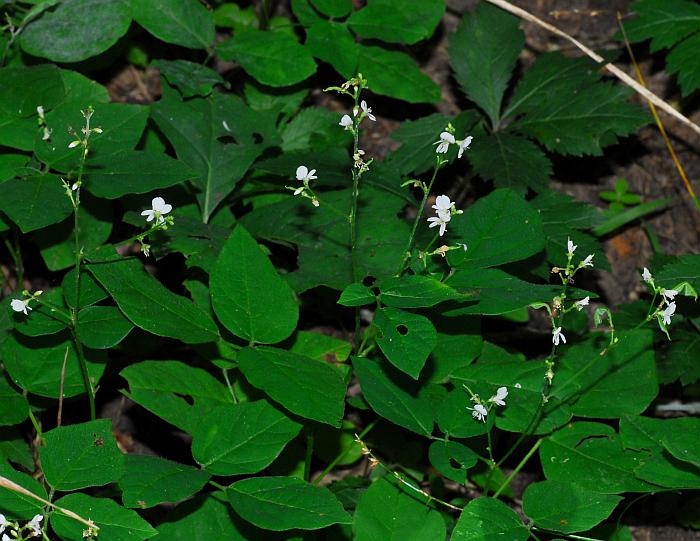Hylodesmum pauciflorum (Nutt.) H. Ohashi & R.R. Mill
Fewflower Tick Trefoil

Native
CC = 8
CW = 5
MOC = 34
© SRTurner
Hylodesmum pauciflorum (Nutt.) H. Ohashi & R.R. MillFewflower Tick Trefoil | |
 |
Native CC = 8 CW = 5 MOC = 34 |
© SRTurner |
|
Family - Fabaceae/Faboideae Habit - Perennial forb from a woody caudex. Stems - Loosely ascending, to 50 cm, solitary or few in loose clusters, sometimes from a spreading base, unbranched or less commonly few-branched from below the midpoint, the median and basal portions sparsely pubescent with minute, mostly hooked hairs and longer, straight, downward-curved hairs, usually also sparsely hairy toward the tip.
Leaves - Alternate, relatively well-spaced, trifoliate, petiolate, stipulate. Petioles 2-7 cm long. Stipules 2-5 mm long, 0.2-0.5 mm wide, at maturity olive green and appressed, shed early. Leaflets with the undersurface lighter than the upper surface but not glaucous; the central leaflet 2-8 cm long, 2-6 cm wide, obovate to rhombic or ovate, angled or tapered (often short-tapered) to a sharply pointed tip; lateral leaflets 3-7 cm long, 2.0-4.5 cm wide, somewhat asymmetrically ovate (the basal side broader than the side adjacent to the central leaflet).
Inflorescence - Loose axillary racemes and panicles, compact in flower, elongated in fruit, terminal and also axillary from the upper nodes, ascending, unbranched or with few, loosely ascending branches, the axis pubescent with sparse to moderate, minute, hooked hairs and often also widely scattered, straight, spreading hairs. Bracts 1-4 mm long, 0.2-0.3 mm wide, linear, sometimes shed early; bractlets sometimes also present, these somewhat shorter than the bracts (to 2.5 mm long), shed early. Flower stalks 2-11 mm long.
Flowers - Calyces bilabiate, olive green, minutely hairy toward the base and with sparse to moderate, longer, straight hairs throughout, the tube 1.5-2.0 mm long, the lobes 0.2-0.5 mm long. Corolla papilionaceous, 5-7 mm long, white. Standard 5 mm long, glabrous. Wing petals spreading, 4 mm long, to 2 mm broad. Keel petals distinct, deflexed, same size as wing petals. Stamens diadelphous, the free apices curled. Tube white and glabrous. Anthers pale yellow, 0.2 mm long. Ovary green, pubescent, 3-4 mm long, compressed. Style glabrous and curved, 1.4 mm long.
Fruits - Loments of 1-3 segments, each 9-12 mm long and 3.5-8.0 mm wide, the upper side of each segment usually not concave.
Flowering - June - September. Habitat - Bottomland and mesic forests, bases of bluffs, streambanks, pond margins. Origin - Native to the U.S. Lookalikes - None. Other info. - This small species is found in scattered counties in Missouri, mostly in the southern half of the state. Beyond Missouri it is found scattered across much of the southeastern U.S. The plant is often missed because of the typically dark habitat in which it grows and its inconspicuous appearance. It broadly resembles other species in the genus but is distinguished by its pure white flowers and short stature. It often forms colonies when growing in favorable conditions, and these sometimes produce few flowers. Photographs taken at the Peck Ranch Wildlife Area, Shannon County, MO., 7-17-01, and in Brown Summit, NC., 7-12-01 (DETenaglia); also at Shaw Nature Reserve, Franklin County, MO, 6-20-2012, and Young Conservation Area, Jefferson County, MO, 7-31-2013 and 8-17-2020 (SRTurner). |